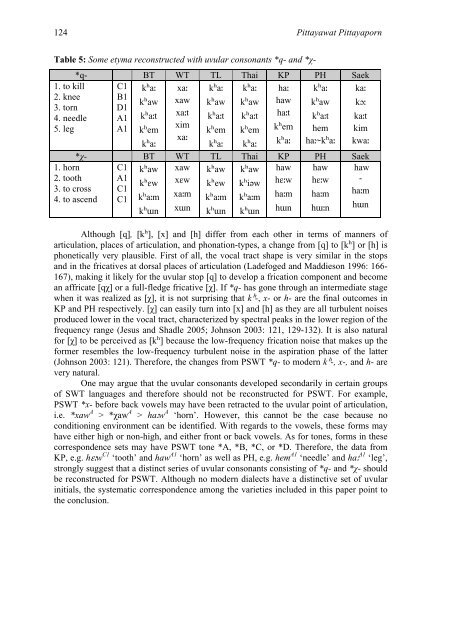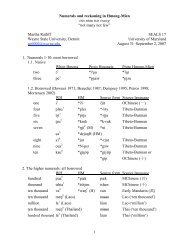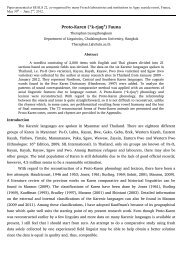proto-southwestern-tai revised: a new reconstruction - seals 22
proto-southwestern-tai revised: a new reconstruction - seals 22
proto-southwestern-tai revised: a new reconstruction - seals 22
Create successful ePaper yourself
Turn your PDF publications into a flip-book with our unique Google optimized e-Paper software.
124 Pittayawat Pittayaporn<br />
Table 5: Some etyma reconstructed with uvular consonants *q- and *χ-<br />
*q- BT WT TL Thai KP PH Saek<br />
1. to kill<br />
2. knee<br />
3. torn<br />
4. needle<br />
5. leg<br />
C1<br />
B1<br />
D1<br />
A1<br />
A1<br />
kʰaː<br />
kʰaw<br />
kʰaːt<br />
kʰem<br />
kʰaː<br />
xaː<br />
xaw<br />
xaːt<br />
xim<br />
xaː<br />
kʰaː<br />
kʰaw<br />
kʰaːt<br />
kʰem<br />
kʰaː<br />
kʰaː<br />
kʰaw<br />
kʰaːt<br />
kʰem<br />
kʰaː<br />
haː<br />
haw<br />
haːt<br />
kʰem<br />
kʰaː<br />
kʰaː<br />
kʰaw<br />
kʰaːt<br />
hem<br />
haː~kʰaː<br />
kaː<br />
kɔː<br />
kaːt<br />
kim<br />
kwaː<br />
*χ- BT WT TL Thai KP PH Saek<br />
1. horn<br />
2. tooth<br />
3. to cross<br />
4. to ascend<br />
C1<br />
A1<br />
C1<br />
C1<br />
kʰaw<br />
kʰɛw<br />
kʰaːm<br />
kʰɯn<br />
xaw<br />
xɛw<br />
xaːm<br />
xɯn<br />
kʰaw<br />
kʰew<br />
kʰaːm<br />
kʰɯn<br />
kʰaw<br />
kʰiəw<br />
kʰaːm<br />
kʰɯn<br />
haw<br />
hɛːw<br />
haːm<br />
hɯn<br />
haw<br />
hɛːw<br />
haːm<br />
hɯːn<br />
haw<br />
-<br />
haːm<br />
hɯn<br />
Although [q], [kʰ], [x] and [h] differ from each other in terms of manners of<br />
articulation, places of articulation, and phonation-types, a change from [q] to [kʰ] or [h] is<br />
phonetically very plausible. First of all, the vocal tract shape is very similar in the stops<br />
and in the fricatives at dorsal places of articulation (Ladefoged and Maddieson 1996: 166-<br />
167), making it likely for the uvular stop [q] to develop a frication component and become<br />
an affricate [qχ] or a full-fledge fricative [χ]. If *q- has gone through an intermediate stage<br />
when it was realized as [χ], it is not surprising that kʰ-, x- or h- are the final outcomes in<br />
KP and PH respectively. [χ] can easily turn into [x] and [h] as they are all turbulent noises<br />
produced lower in the vocal tract, characterized by spectral peaks in the lower region of the<br />
frequency range (Jesus and Shadle 2005; Johnson 2003: 121, 129-132). It is also natural<br />
for [χ] to be perceived as [kʰ] because the low-frequency frication noise that makes up the<br />
former resembles the low-frequency turbulent noise in the aspiration phase of the latter<br />
(Johnson 2003: 121). Therefore, the changes from PSWT *q- to modern kʰ-, x-, and h- are<br />
very natural.<br />
One may argue that the uvular consonants developed secondarily in cer<strong>tai</strong>n groups<br />
of SWT languages and therefore should not be reconstructed for PSWT. For example,<br />
PSWT *x- before back vowels may have been retracted to the uvular point of articulation,<br />
i.e. *xaw A > *χaw A > haːw A ‘horn’. However, this cannot be the case because no<br />
conditioning environment can be identified. With regards to the vowels, these forms may<br />
have either high or non-high, and either front or back vowels. As for tones, forms in these<br />
correspondence sets may have PSWT tone *A, *B, *C, or *D. Therefore, the data from<br />
KP, e.g. hɛːw C1 ‘tooth’ and haw A1 ‘horn’ as well as PH, e.g. hem A1 ‘needle’ and haː A1 ‘leg’,<br />
strongly suggest that a distinct series of uvular consonants consisting of *q- and *χ- should<br />
be reconstructed for PSWT. Although no modern dialects have a distinctive set of uvular<br />
initials, the systematic correspondence among the varieties included in this paper point to<br />
the conclusion.





